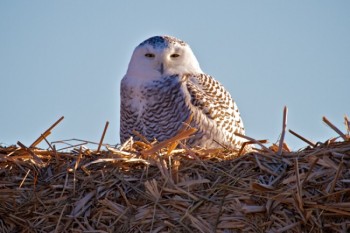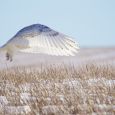The Gift of South Dakota
Subscriptions to South Dakota Magazine make great gifts!
Subscribe today — 1 year (6 issues) is just $29!
Snow Birds
Dec 28, 2011
It’s the last week of December and South Dakotans have just celebrated their first brown Christmas in years. It looks as if a brown New Year’s is on tap. In fact the only white we may see for the next few weeks are the snowy owls that are flying further south than many people can remember.
Jim Lewandowski, the office assistant at Sand Lake National Wildlife Refuge northeast of Aberdeen, says they have seen an abundant number of snowy owls there so far this winter. Terry Jordre, a Brown County birder, told the Aberdeen American News that he’s seen plenty of the owls dotting the back roads of northern South Dakota.
Snowy owls breed on the Arctic tundra and come south during the winter in search of food. The nearly pure white birds can often be found as far south as Nebraska in winter, but this year they are flying into Kansas. Three were seen last week at a lake in Kansas City.
Experts seem to agree that the owls are venturing outside their normal range because of a food shortage. They prefer lemmings, whose populations fluctuate every three to five years. When lemmings are in short supply, owls seek out dietary supplements of rodents, rabbits, birds and fish, all of which are plentiful in South Dakota and other Great Plains states.
Unfortunately the owls have a difficult time adapting to their southern surroundings. They are used to life on the tundra, so their interactions with humans are limited. The owls aren’t used to avoiding cars, and many have been hit. Some owls are curious. “They’ll let you get close enough that they might even swoop down at your vehicle,” Lewandowski says. “They’ve done that up here.”
So if you have travel plans over the New Year’s weekend, keep your eyes peeled. You might spot a snowy owl perched on a fencepost or high in a tree near a lake or slough. The white owls will surely stand out against the browns of our snowless winter.











Comments
Emily Kiel
The Lake Andes National Wildlife Refuge has had as many as 30 in the area this winter. They seem to be dispersing now, with about 8-10 being seen by birders on a regular basis.
Another possible reason for this irruption, or invasion, of the birds is that the lemming population was so high this past summer in the Arctic that most of the fledglings survived. They do not have established territories for hunting this winter, and so moved south in search of food. Some raptor specialist friends in British Columbia, Canada shared this concept with us early this winter. The study of lemmings in 2011 showed that the population was astoundingly high.
No matter the cause, we are so lucky to see so many of these magnificent birds this winter! Enjoy them everyone, and good birding.
Maggie Engler
Co-founder
Black Hills Raptor Center
Rapid City